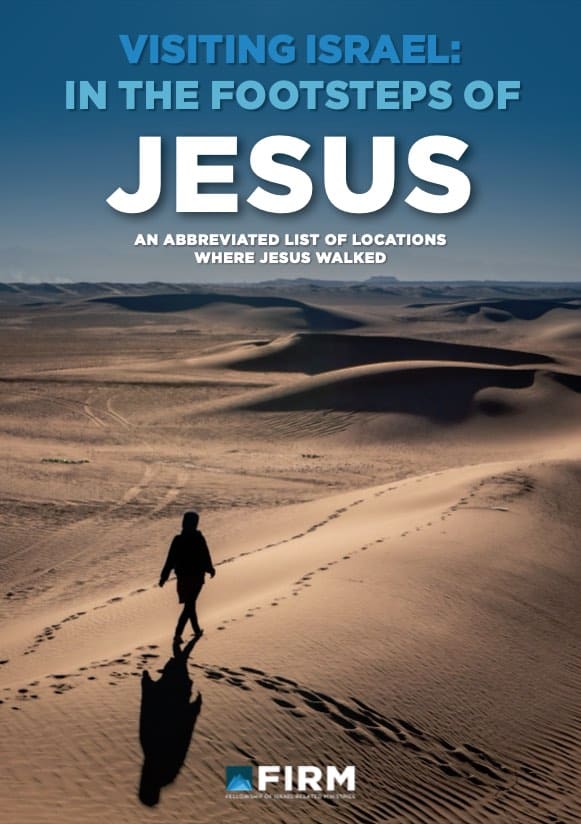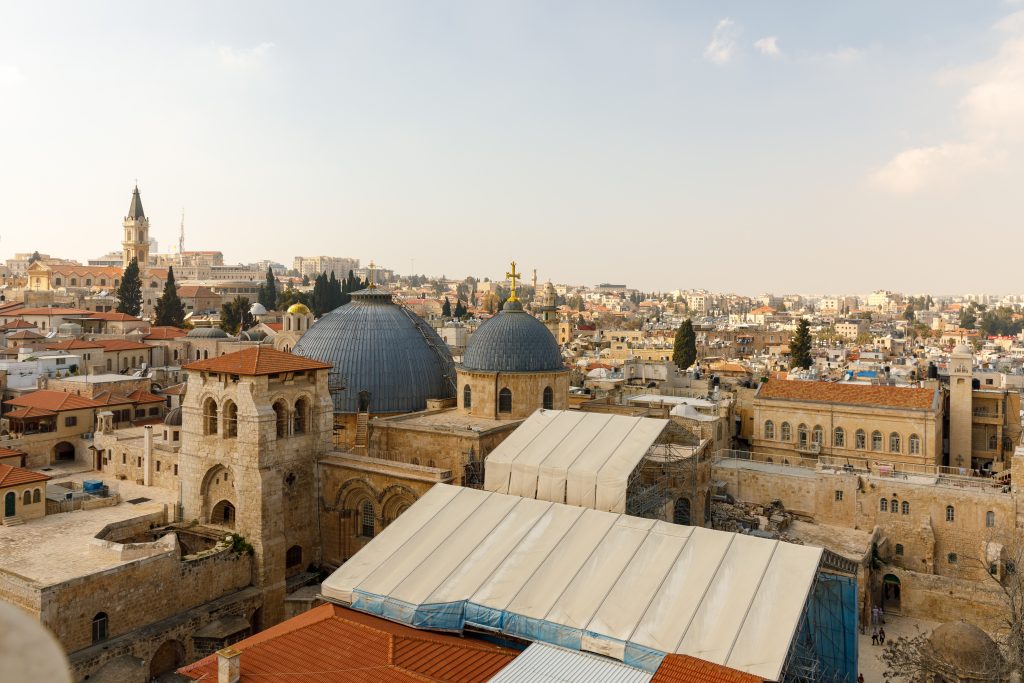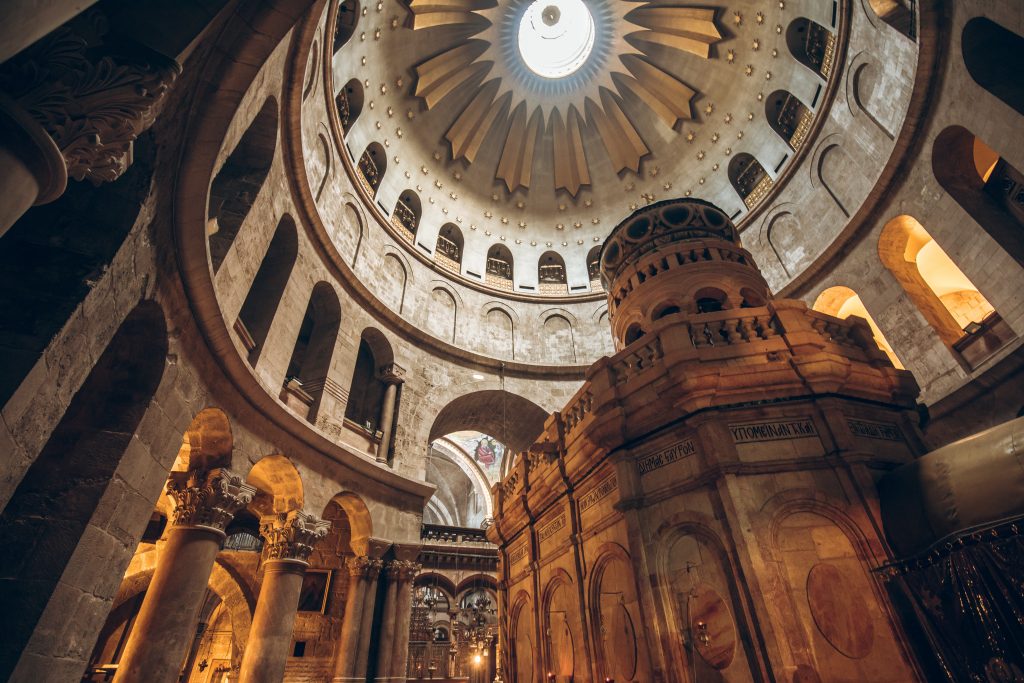For most Christian travelers in Jerusalem, and especially the ‘first-timers’, the place of Jesus’s death and resurrection is at the top of their list. Almost everyone wants to go to “the spot” to pray and put themselves in the shoes of a 1st century disciple.
Ironically, this is not exactly an easy task. There are very few locations in Israel where everyone agrees “this is the exact spot” where a particular biblical event happened. Crucifixion and burial of Jesus is no different.
Personally, I know of not two, but three different locations where it could have happened. I’ve heard guides and believers alike provide thoughtful reasoning, compelling facts and passionate beliefs as to why their location is the one.
In my ongoing experience of leading Ezra Adventures trips to Israel, it’s a conversation I have frequently. Here is what you will hear about the two most popular sites, The Church of the Holy Sepulchre and The Garden Tomb.
Location of Jesus’ Death & Resurrection: What We Know
Before we start evaluating these locations, it is good to know what we are looking for. The book of John provides the best description:
“They took Jesus, therefore, and He went out, bearing His own cross, to the place called the Place of a Skull, which is called in Hebrew, Golgotha.” John 19:17
“Now in the place where He was crucified there was a garden, and in the garden a new tomb in which no one had yet been laid. Therefore because of the Jewish day of preparation, since the tomb was nearby, they laid Jesus there.” John 19:41-42
Somewhere outside the city walls there was a location called “the place of the Skull” that was near a garden with a new (unused) tomb. Yet, before we already draw any conclusions, there is some history and archeology to consider.
Holy Sepulchre – History and Background
Considered to be the traditional location of the crucifixion and the tomb, this location is hard to imagine in Biblical days. Mainly because it is now “inside” a large stone church.
Nevertheless, church tradition says that early believers met at this location as early as the mid first century to pray and worship.
The Romans destroyed Jerusalem at the end of the 1st century. There is evidence that in early 2nd century the Romans built a pagan temple at this location, dedicated to Greek gods.
This fact is fascinating and important to consider. Because when the Romans would conquer a city or region, they would build temples at locally significant spiritual or religious locations. They did it to stamp out local religious traditions with the intent of assimilating the population to Roman culture.
However, there is no record of a significant historical Jewish site of worship at this spot. Something of local and spiritual significance must have happened here that caused the Romans to build a pagan temple.
Search for the Hill and the Tomb
Later in the 4th Century, Constantine’s mother Helena, came looking for “the spot”. In result, she ordered to build a church around this location. While there is much dispute about her mission and intent, a common 4th century Byzantine style church was built here in the shape of a cross.
Builders would construct the building in a traditional style. This means they would place the most significant relic or treasure of the church at the head of the cross.
Through the centuries, the church has been destroyed, rebuilt and redesigned several times. Yet, if you know where to look in this church today, you can find a room that is centuries older than the rest of the construction.
Leave the crowds in the large rotunda and step thru an archway. You will enter a small room where the head of that cross in the early Byzantine design stood. Inside, you will find a wealthy family tomb, chiseled out of the rock, that has been dated to the 1st century.
Garden Tomb – History and Background
The popular evangelical choice, The Garden Tomb is a beautiful spot. Relatively recently discovered, in comparison to the ancient church, this location was discovered by a British General in 1842. But it was first spotted by Greek landowners looking for water.
The Garden Tomb does have some compelling aspects. Archeology has confirmed it was an ancient garden for more than just flowers. A well, an underground cistern and a wine press dating to the 2nd temple period were all found here.
Nearby, there is a sizable family tomb, chiseled out of the bedrock. Inside the tomb there are crosses found dating to the Byzantine period.
Not far from here there is an overlook, although crumbling today, where visitors can notice a rock ledge. Many say it looks like a face or a skull – perhaps marking “the place of the skull” that the Scriptures spoke of.
Doubts Regarding the Holy Sepulchre
Like with everything in Israel, there are lots of opinions and doubts about both locations.
Helena, who built the Church of the Holy Sepulchre, was not known for her accuracy in biblical locations.
Perhaps motivated by other intentions, Helena often chose biblical locations herself. And she ordered to build churches based on visions of her personal spiritual encounters. The church, along with the city, has been destroyed several times, each time being rebuilt in a different way.
Various Christian groups through the centuries fought over it, then lost it, only to regain control and lose it again. Each group claimed to have parts of the “true cross” and the real holy tomb.
This have turned the Holy Sepulchre into more of an eastern shrine and muddied the accuracy of it. Just because tradition says so, doesn’t mean it’s the real deal.
Doubts Regarding the Garden Tomb
On the other hand, The Garden Tomb, while still outside the old walls today, doesn’t fare much better. Discovered about 1800 years after the event, the tomb’s history is based on a lot of speculation.
In the mid 1800s, it was decided that a nearby rock ledge looked a lot like a skull. Soon, excavations found remnants of an ancient garden and wine press from the 2nd temple period.
By the late 1880s, years after the tomb was uncovered, it was being passionately supported by many western Christian leaders as “the spot”. They were using metaphor and typology interpretation of Scripture to support their view.
While everything seemed to potentially fit the biblical account, the science didn’t quite agree. Modern archeology has determined that the age of the tomb is from somewhere between the 5th- 8th century BC.While the speculative puzzle pieces fit together rather nicely, one of them didn’t. Meaning, this was not a “new tomb” in the time of Jesus but was already hundreds of years old.
Disputes Over the Years
While that discussion continues, let’s look back to the Bible. The last topic that Jesus spoke to His disciples and prayed about before the crucifixion was perfect unity.
“…that they may all be one; even as You, Father, are in Me and I in You; That they also may be in Us, so that the world may believe that You sent Me. The glory which You have given Me I have given to them, that they may be one, just as We are one; I in them and You in Me, that they may be perfected in unity; So that the world may know that You sent Me, and loved them, even as You have loved Me.” John 17:21-24
Today, in Jerusalem, where Jesus said His act of sacrifice would bring unity with God and each other, this has rarely been the case.Unfortunately, the Church of the Holy Sepulchre, and at times the Garden Tomb, have been known for anything but unity. Instead, they echo with disputes, mistrust and disagreements as the rest of the world watches.
Conflicts at the Holy Sepulchre
At the Church of the Holy Sepulchre, the family who has held the key for the church for generations, is a Muslim family. Simply because the Christians couldn’t agree on who should be in charge.
There is a wooden ladder outside a second-floor window, right above the entrance. It has been there for well over 100 years, simply over a territorial dispute. Once inside, the church itself houses not one, two or even three different Christian denominations. No, there are six!
Inside you will find designated chapels and areas governed by Greek Orthodox, Roman Catholics, Armenians, Egyptian Copts, Syrian-Jacobites, and Ethiopians. There are clear regulations for when each group has time allocated for their daily services, even more so on holidays.
If you brave the crowds during the holidays, you will see signs with arrows pointing in six different directions to each group’s true “holy tomb”. If that wasn’t enough, most of them don’t even like each other. You can even find videos of fist fights at the church online.
Challenging Evangelicals at Garden Tomb
Many in the evangelical Christian world, who recognize the internal church fighting at the Holy Sepulchre, stand in judgment and scoff at the religious squabbles. Western Christians tend to be critical of these eastern denominations.They insist the Garden Tomb is the much better location, and “the real one”, because it’s more peaceful and “just feels right”.
I’ve heard many Christian tourists from western countries call the Church of Holy Sepulchre “spooky and dark”, not realizing the judgmental attitude in their hearts. They are critical of those who choose this place to call on the name of Jesus, because it is different from what they know.
If we are not careful, we ourselves become argumentative, self-righteous and distrusting. And if there ever was a definition of shocking disunity among Christians worldwide, it maybe this one. Sadly, the arguments surrounding where the actual tomb of Jesus is, is an unfortunate example.
The Meaning of Jesus’ Death and Resurrection
Thankfully, often what the enemy intends for evil, God intends for good. The message of the gospel is one of loving God and loving others through forgiveness and restoration. This situation is in need of an earth-shaking demonstration of love.We need grace and acceptance through the power of the resurrection AT the place of the resurrection.
According to the Scriptures, before the end, there will be a bride (community of believers) who is without spot or wrinkle. And she will be known by our love. Thus, it is not about being right. It is about demonstrating His love.
When travelers, unfamiliar with these local dramas, simply want to see and worship at the tomb of Jesus, what are they to do? When I lead visitors around Jerusalem, the answer is simple – I take them to both locations.
The fact is, all the proposed locations have several things in common. They are all in Jerusalem, they teach profound lessons, and give us a lot to learn. All of these locations are within walking distance of each other. All were outside the city walls in the first century.
But most importantly, each tomb is empty.
The Empty Tomb
Today, we sometimes miss the point and are still looking for what Mary was looking for – where the body was laid.
Mary was so consumed with this, that she didn’t recognize the One for whom she was looking. He was standing in front of her, speaking to her in her own language.
“And they said to her, ” Woman, why are you weeping?” She said to them, “Because they have taken away my Lord, and I do not know where they have laid Him.” When she had said this, she turned around and saw Jesus standing there, and did not know that it was Jesus.
Jesus said to her, “Woman, why are you weeping? Whom are you seeking?” Supposing Him to be the gardener, she said to Him, “Sir, if you have carried Him away, tell me where you have laid Him, and I will take Him away.” Jesus said to her, “Mary!” She turned and said to Him in Hebrew, “Rabboni!” (which means, Teacher). (John 20:13-16)
Gift of Resurrection
How many times are we desperately seeking the Lord, yet don’t see Him directly in front of us? The gift of the resurrection is that it happened! When we focus on the location and not the event itself, we are missing the point.This was the angel’s message for Mary, and applies to us today: “Why do you seek the living One among the dead? He is not here, but He has risen.” (Luke 24:5-6)
Come to Jerusalem, the City of the Great King, and watch your Bible come alive. Marvel at the restoration process of the city, the people and the land, according to biblical prophecy. See where Jesus walked and taught.Yet, come with your eyes firmly fixed on the One who lives and not the dead. See what He’s doing right now, hear Him say your name and be changed again and again.

Visiting Israel: In the Footsteps of Jesus: Free PDF Download
It is quite exciting to think that while touring Israel you are walking on the same land that Jesus did.
Whether it is the reason why you came to Israel or not, it is worth noting which locations were significant to His life and ministry. God chose this piece of land to send His Son to live on earth. Many archeological findings confirm the locations mentioned in the Bible.
Articles Related to the Tomb of Jesus
Estimated reading time: 12 minutes




